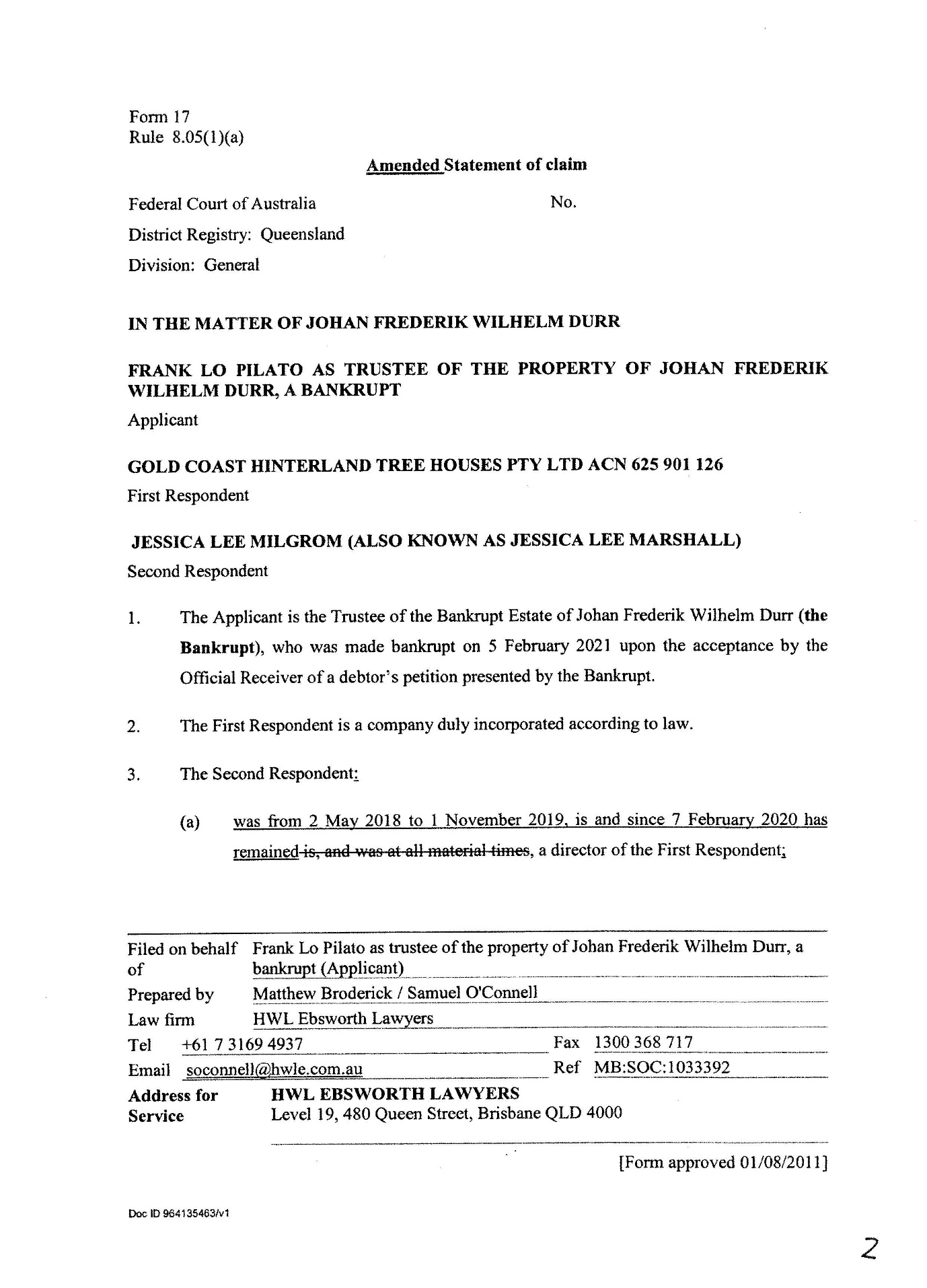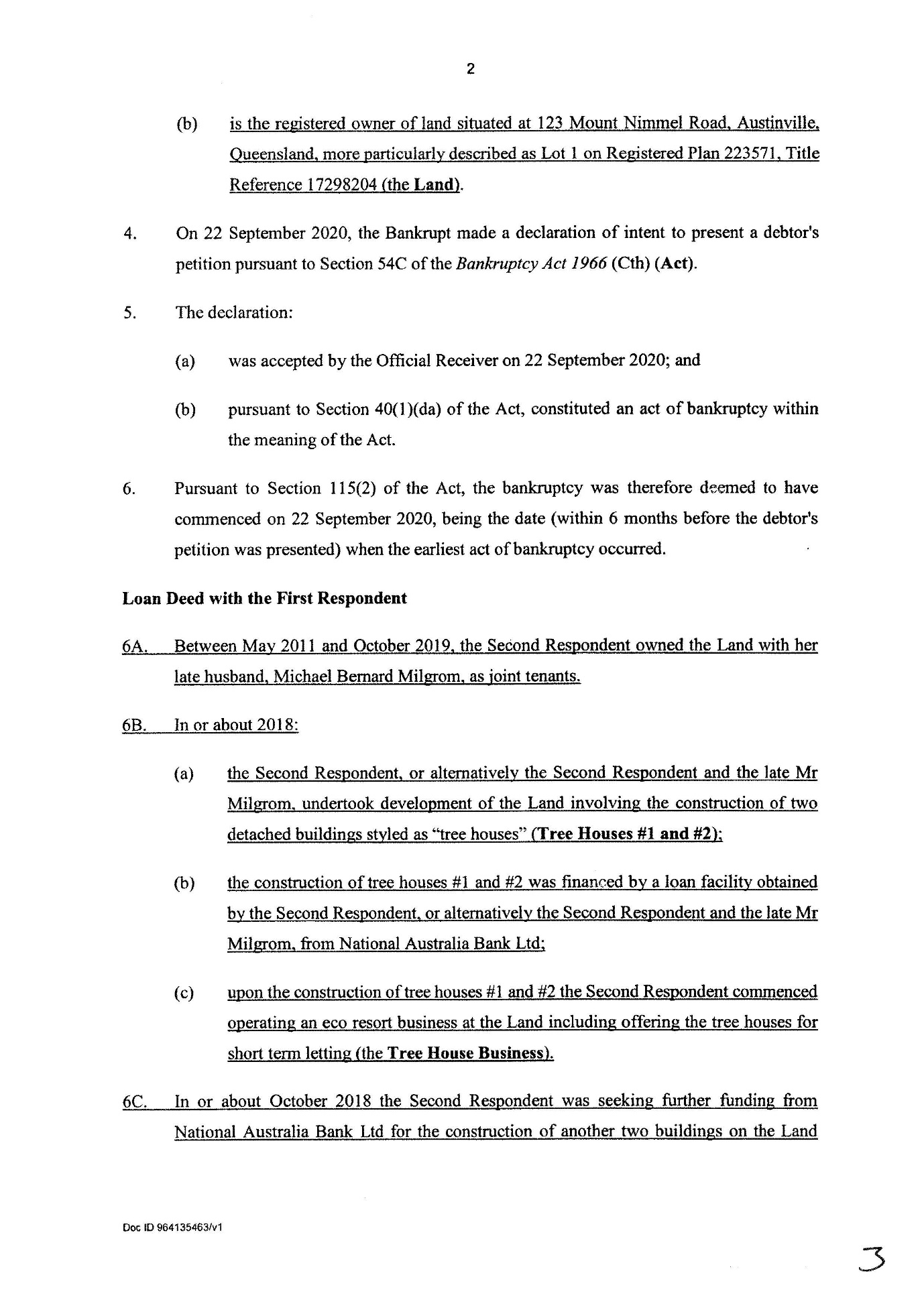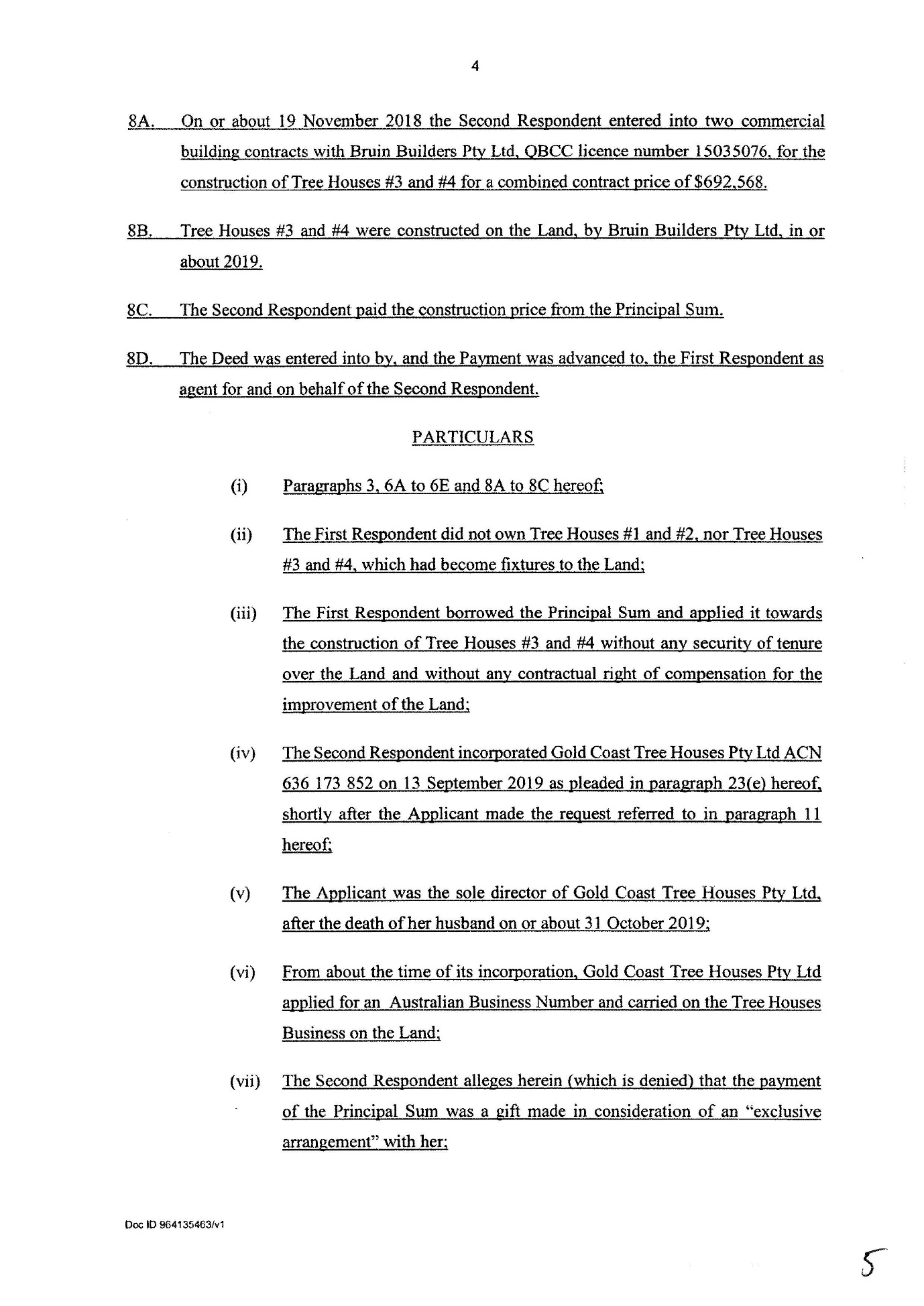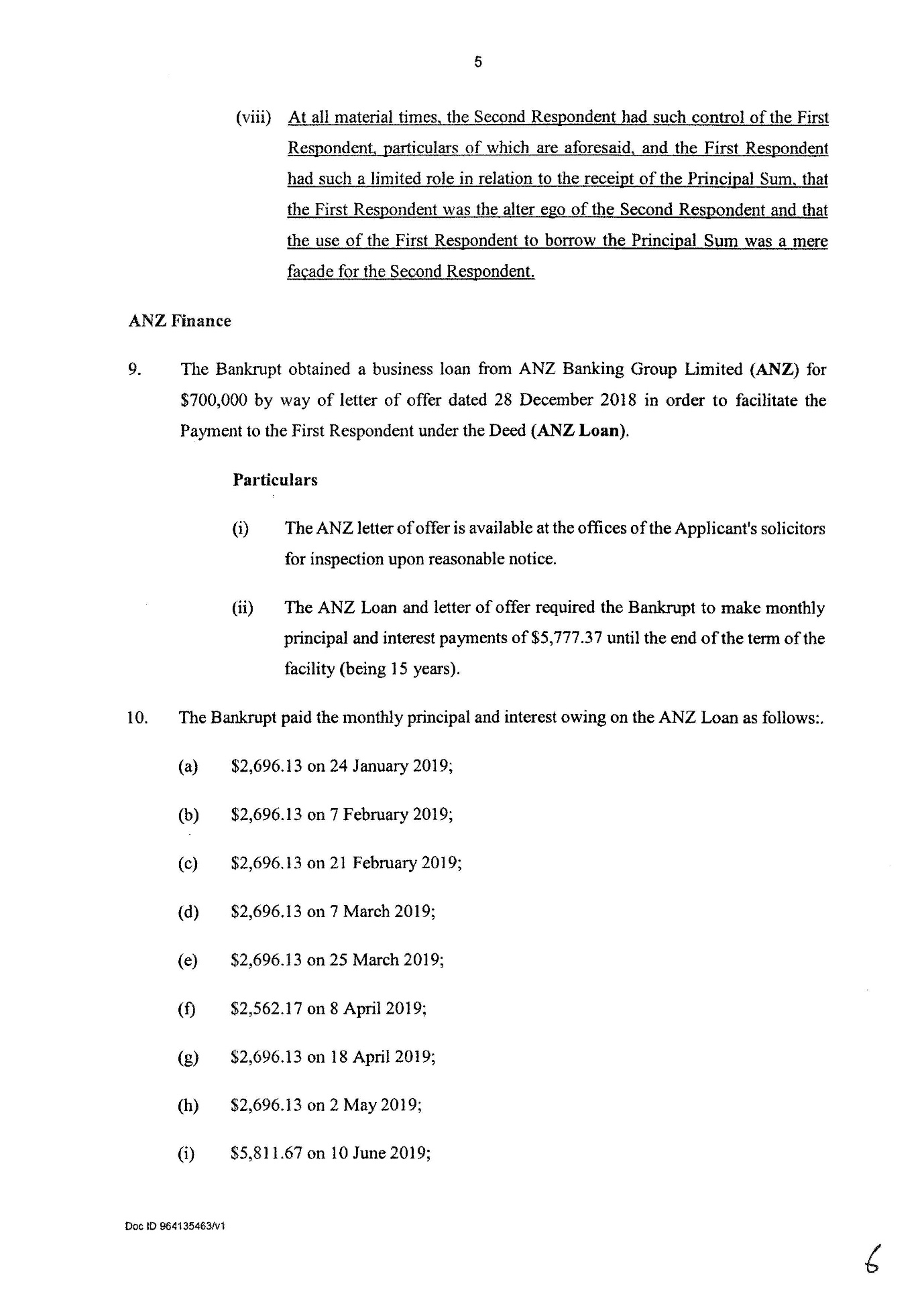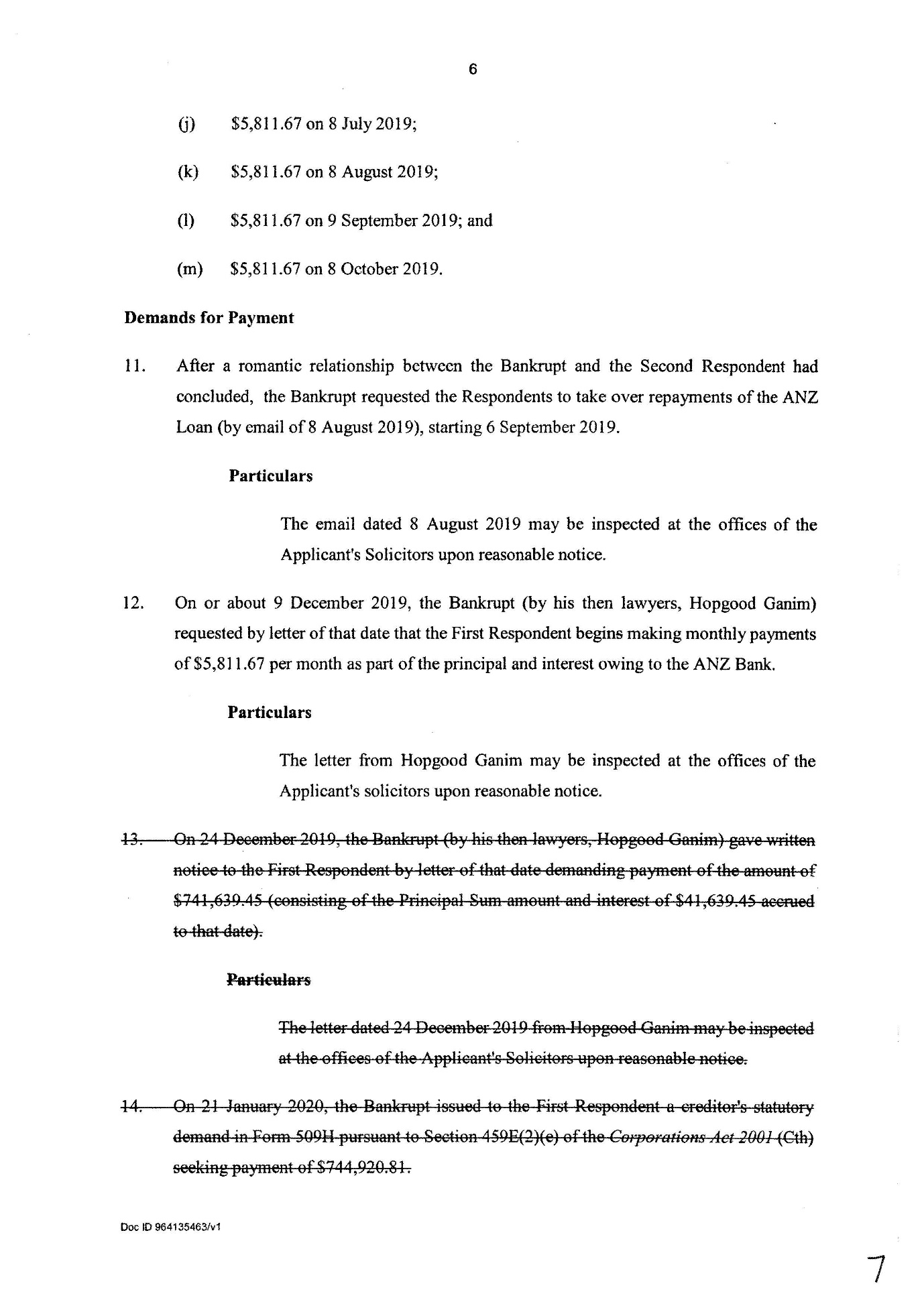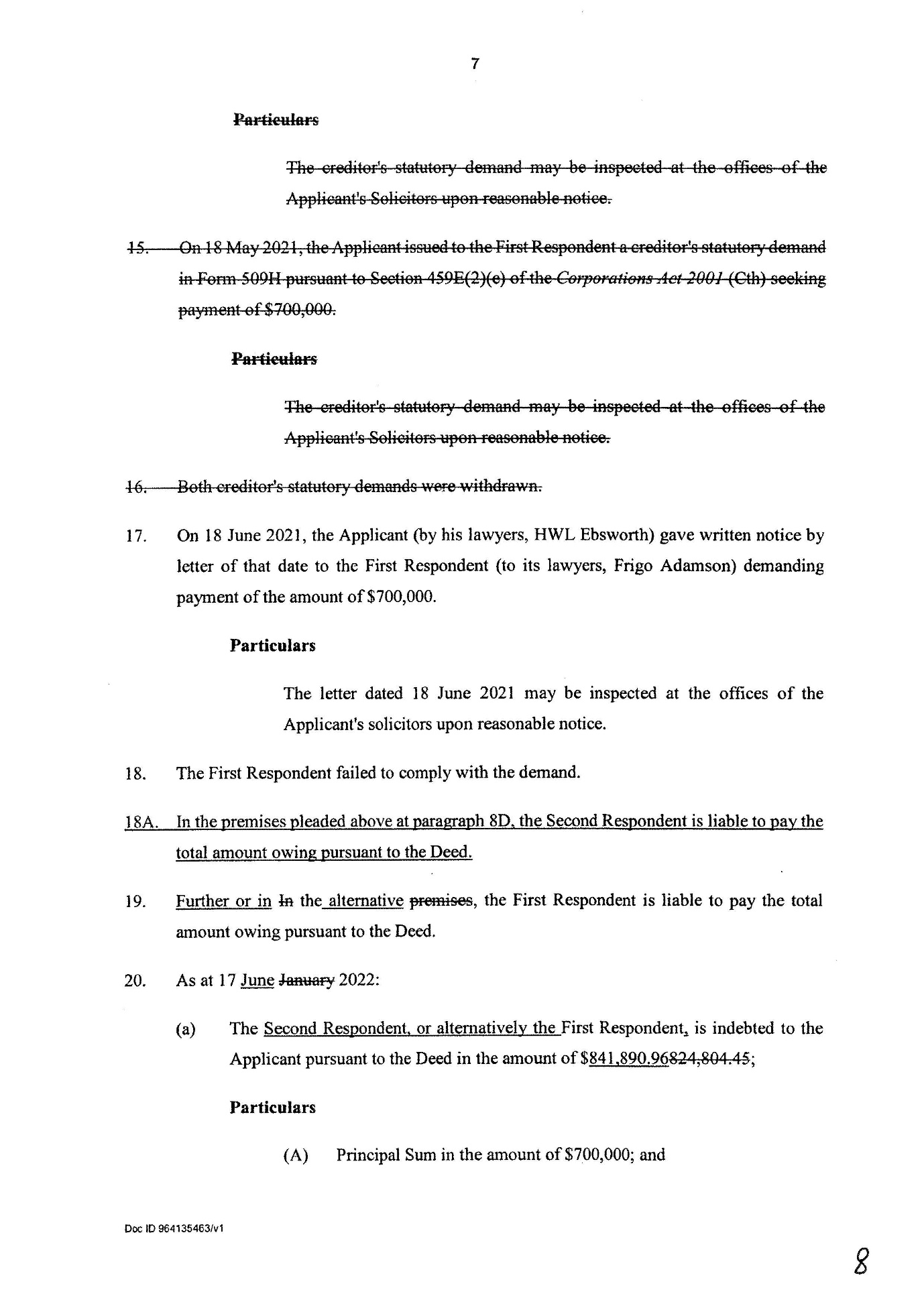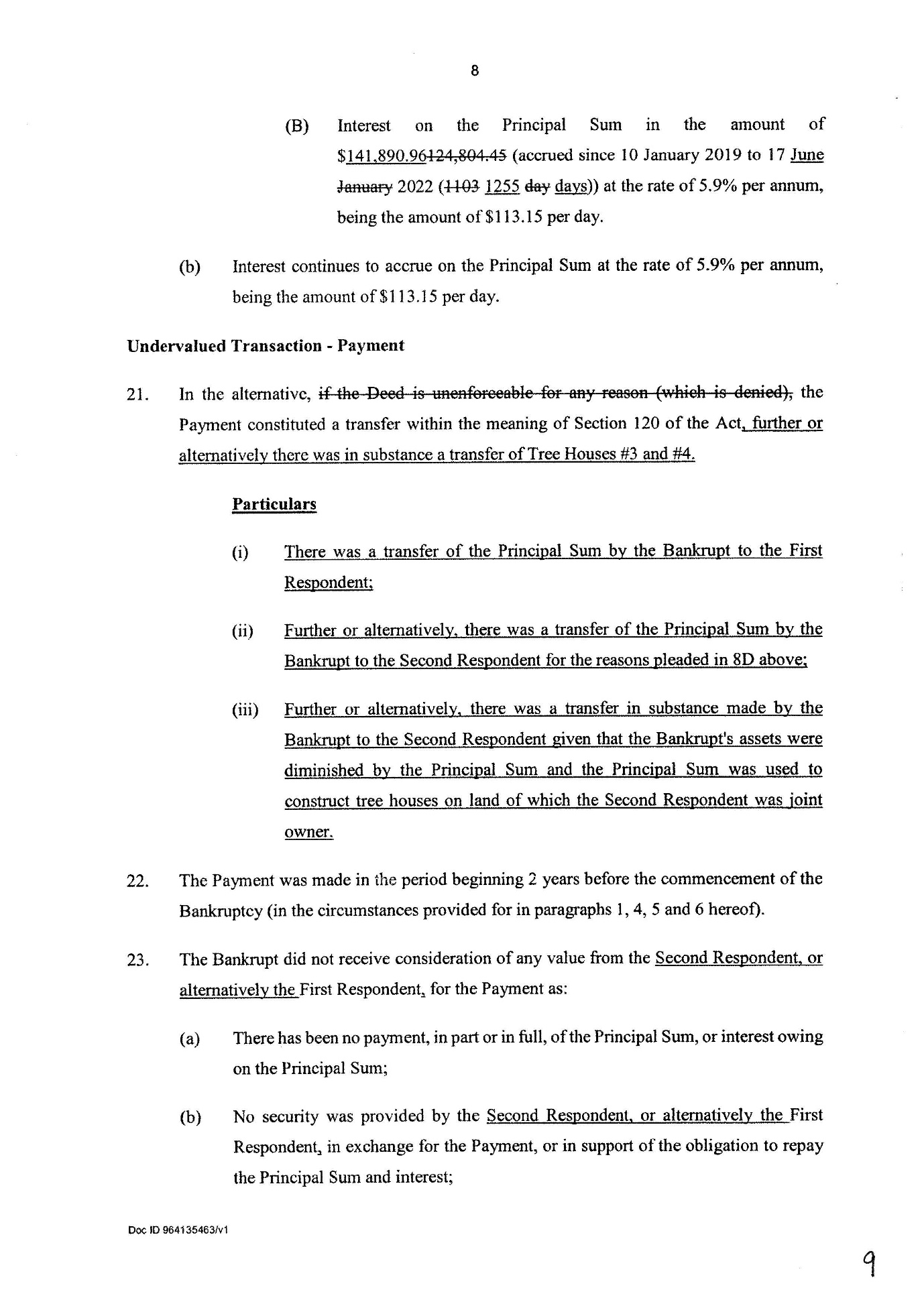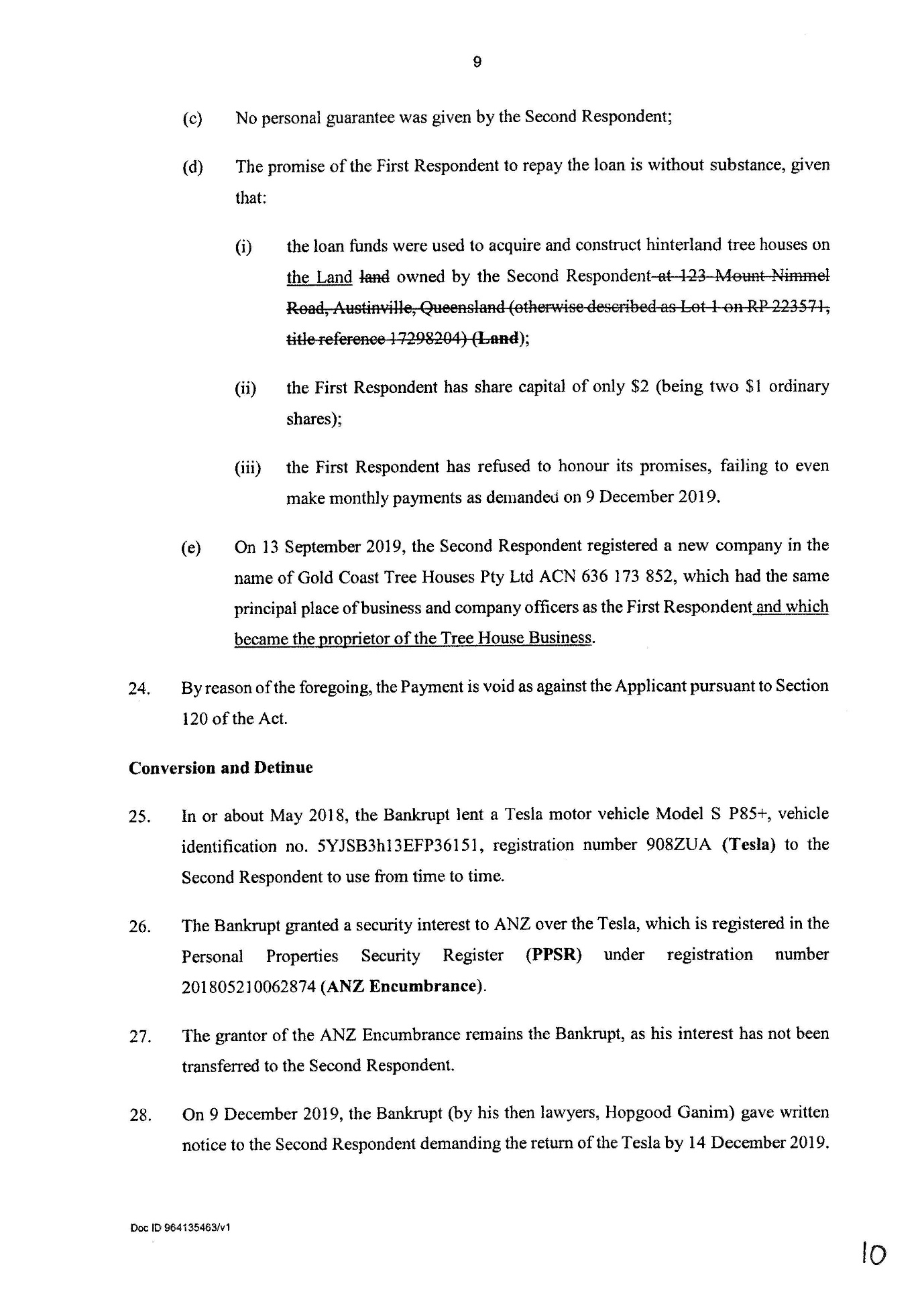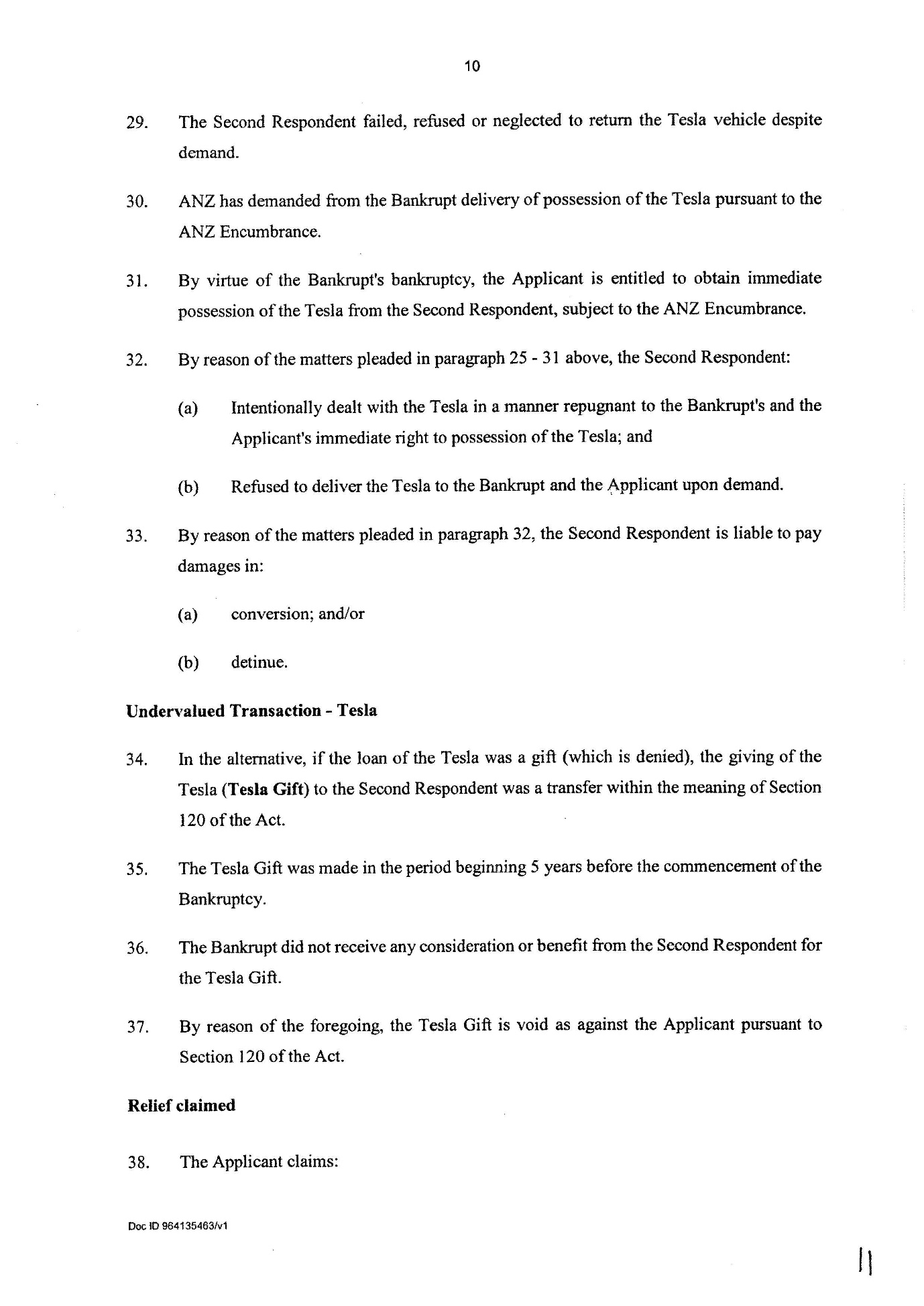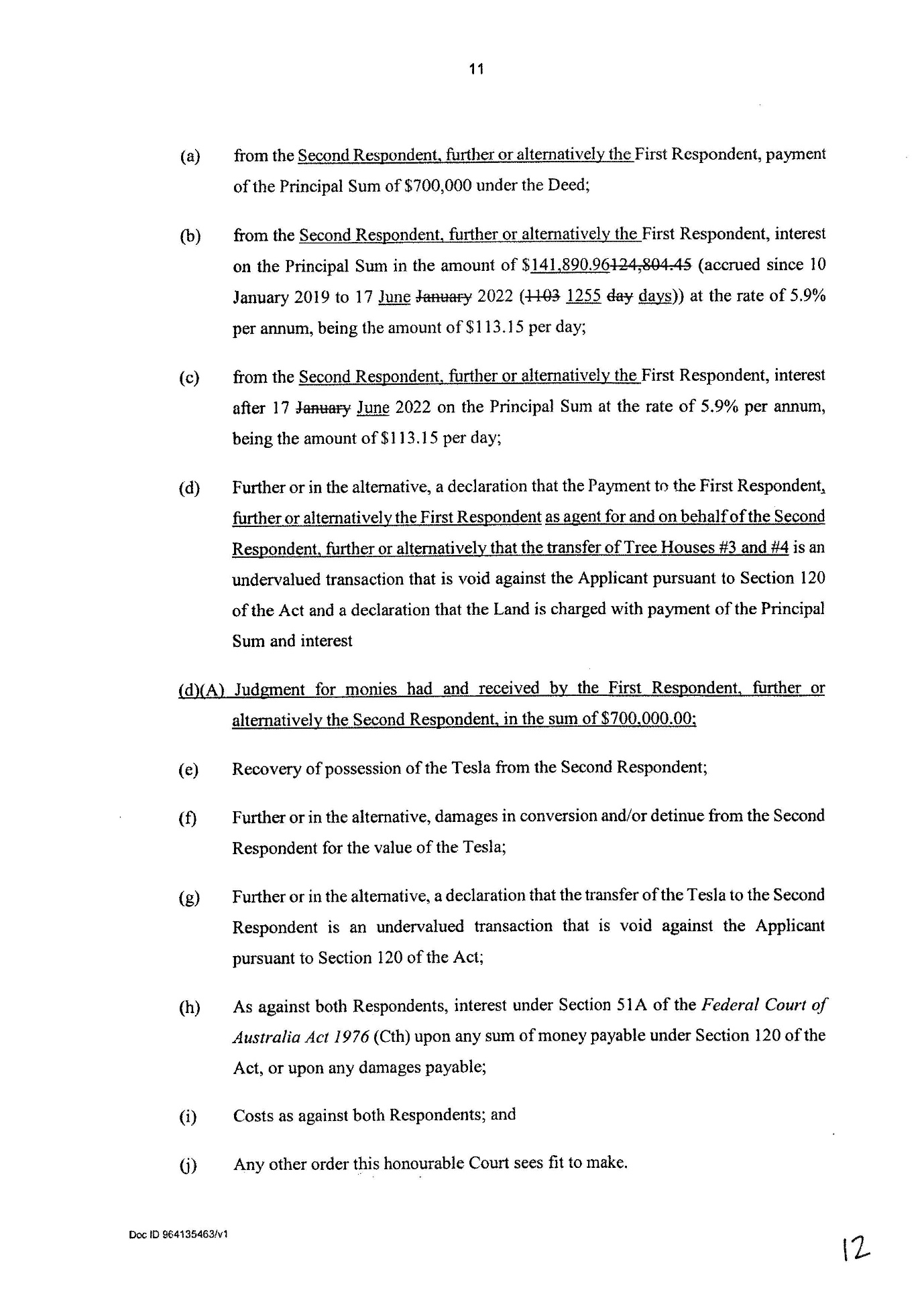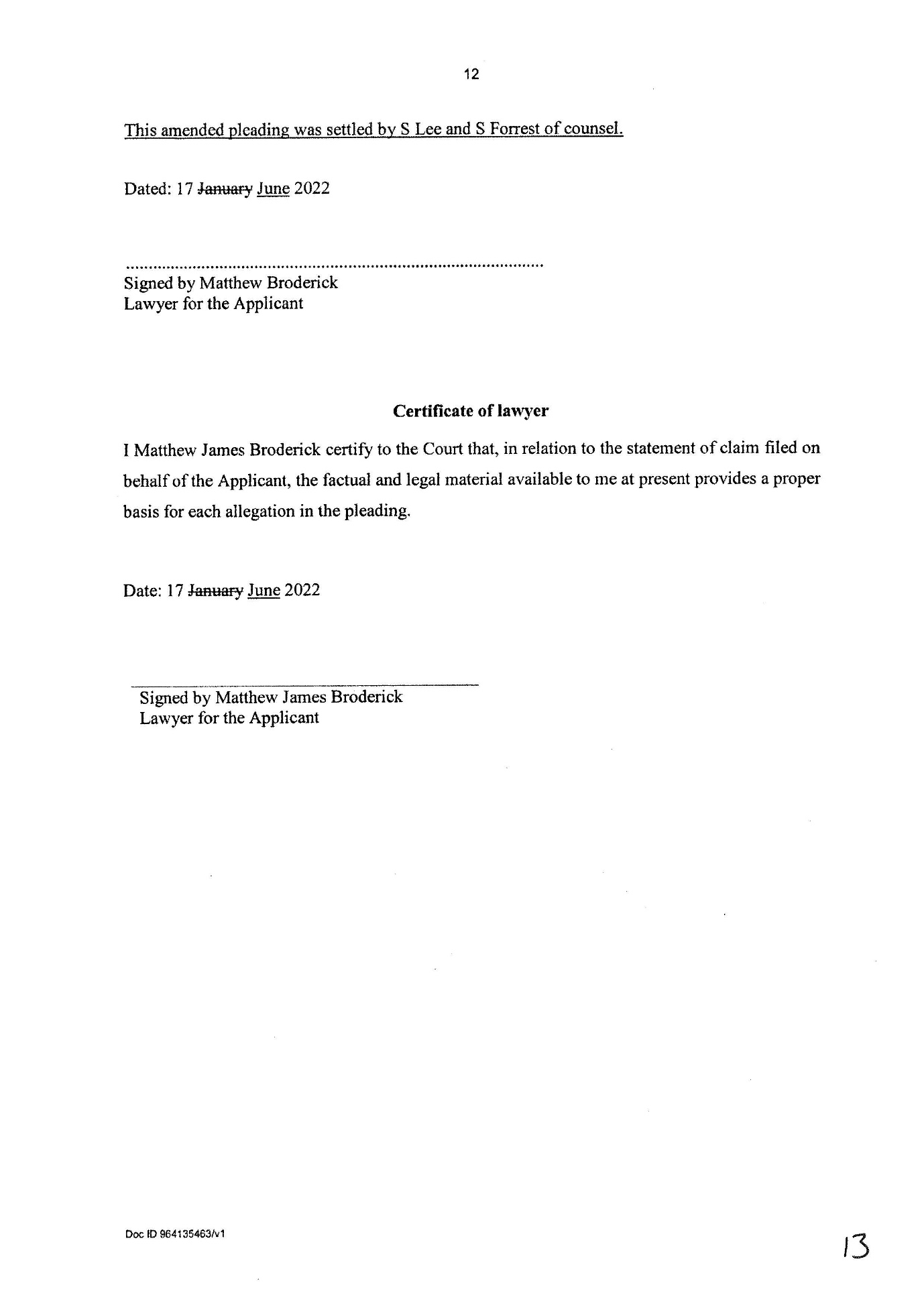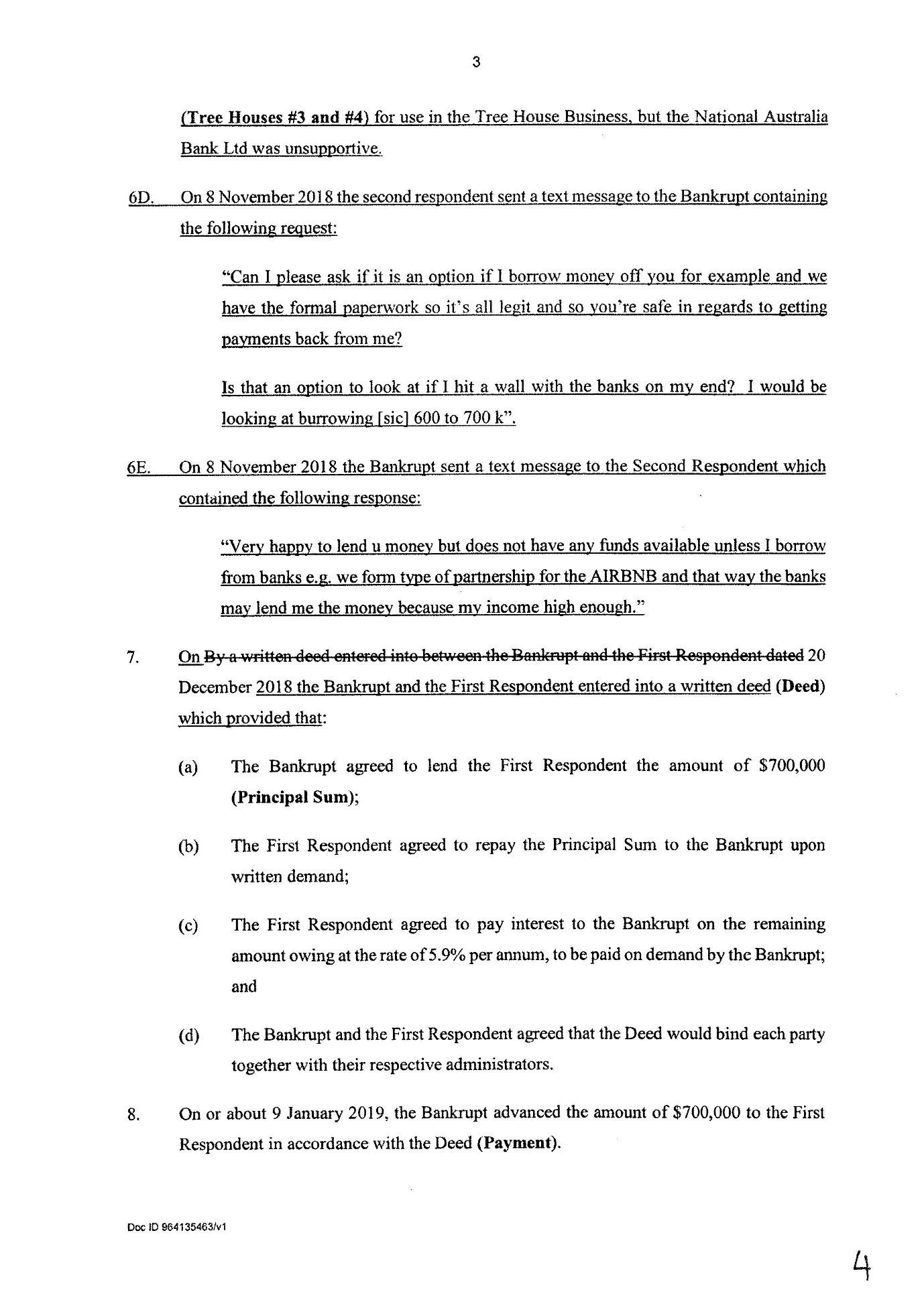Federal Court of Australia
Lo Pilato (Trustee) v Gold Coast Hinterland Tree Houses Pty Ltd [2022] FCA 814
ORDERS
DATE OF ORDER: |
THE COURT ORDERS THAT:
1. Leave be granted to the applicant to file in Court an amended interlocutory application on the basis that the solicitors for the applicant will file that document electronically forthwith.
2. The amended interlocutory application be dismissed.
3. The applicant pay the respondents' costs of and incidental to the amended interlocutory application, such costs to be taxed by a registrar if not agreed.
THE COURT NOTES THAT:
A. The filing in Court of the amended interlocutory application is neither consented to nor opposed by the respondents.
Note: Entry of orders is dealt with in Rule 39.32 of the Federal Court Rules 2011.
(REVISED FROM TRANSCRIPT)
LOGAN J:
1 Mr Frank Lo Pilato (Trustee) is the trustee of the bankrupt estate of Mr Johan Frederick Wilhelm Durr, a bankrupt. The Trustee has instituted proceedings against Gold Coast Hinterland Tree Houses Pty Ltd (GCHTH) and Ms Jessica Lee Milgrom, also known as Jessica Lee Marshall.
2 As presently constituted the proceedings have two dimensions. As against GCHTH, the Trustee claims payment from that company in the principal sum of $700,000 together with interest thereon said to be owing pursuant to a deed, dated 20 December 2018, entered into between the bankrupt and that company. Ms Milgrom is not personally in jeopardy in relation to that aspect of the proceeding. She is, however, in jeopardy in relation to a separate claim made by the Trustee for conversion and detinue in respect of a Tesla motor vehicle, said to have been lent by the bankrupt to her but not returned upon demand.
3 For completeness, it should be added that, in relation to the claim against GCHTH, as the statement of claim presently stands, an alternative case is raised that if the deed is for any reason unenforceable the payment of $700,000 constituted a transfer within the meaning of s 120 of the Bankruptcy Act 1966 (Cth) made in the period beginning two years before the commencement of the bankruptcy.
4 The proceedings were commenced some six months ago, the originating application having been filed on 18 January 2022. Initially, the case was managed by Downes J. On 3 February 2022 her Honour made orders for the completion of pleadings, such that a defence would be filed by 4 March 2022 and any reply by 1 April 2022. At that time, her Honour referred the proceeding for mediation before a registrar of the court, the mediation to be concluded not later than 29 April 2022.
5 As it happens, the proceeding did not resolve by mediation. It was listed for case management on 13 May 2022.
6 On 13 May 2022, her Honour ordered:
(a) That the reply be filed by 27 May 2022. As it happens, the reply was not filed by that date but, rather, on 10 June 2022. That late filing was not, however, controversial between the parties.
(b) On or before 10 June 2022, the parties give one to the other standard discovery.
7 Thereafter the case came to be allocated to my docket in the ordinary course of the Court’s administration.
8 On 14 June 2022, I brought the case back for case management. At that time, the Trustee, by his counsel, foreshadowed the making of an application for leave to amend the statement of claim. Also on 14 June 2022, I made orders which varied the existing provision in respect of discovery to take account of the contingency of an application for leave to amend the statement of claim. I also listed the case for trial for three days to commence 17 October 2022. That listing was based on an estimate provided by counsel for each of the parties at the case management hearing. Necessarily, of course, the estimate provided for the Trustee, did not take into account the precision of the proposed amended statement of claim as now before the court. But the estimate was made against the background of counsel’s awareness of a proposed amendment and the general nature thereof.
9 As proposed, the amendments to the statement of claim and related amendments to the originating application are extensive. The terms of the amendments proposed are annexed to this judgment. The proposed amendments would see, for the first time, Ms Milgrom being exposed to direct personal liability in relation to the claim for $700,000.
10 One basis upon which it is proposed to allege that Ms Milgrom was personally liable is that GCHTH was but an agent for her. Another is that that company was her alter ego and the use of the first respondent to borrow the principal sum was a mere façade for the second respondent (see proposed paragraph 8B(viii)).
11 In Aon Risk Services Australia Ltd v Australian National University (2009) 239 CLR 175 (Aon), at [103], it is stated in the joint judgment:
The fact that an explanation had been offered for the delay in raising the defence was regarded as a relevant consideration in J L Holdings. Generally speaking, where a discretion is sought to be exercised in favour of one party, and to the disadvantage of another, an explanation will be called for. The importance attached by rule 21 [of the relevant rules of the court of the Australian Capital Territory] to the factor of delay will require that, in most cases where it is present, a party should explain it. Not only will they need to show that their application is brought in good faith, but they will also need to bring the circumstances giving rise to the amendment to the court's attention, so that they may be weighed against the effects of any delay and the objectives of the rules. There can be no doubt that an explanation was required in this case.
12 Having regard to the overarching purpose of civil litigation as expressed in the Federal Court of Australia Act 1976 (Cth) (Federal Court Act), and the related obligations that fall on parties to proceedings in this Court, that statement in Aon is just as apt in this Court. That said, in the Full Court in Cement Australia Pty Ltd v Australian Competition and Consumer Commission (2010) 187 FCR 261, at [51], it was observed of Aon:
Aon Risk is not a one size fits all case. Whilst various factors are identified in the judgment as relevant to the exercise of discretion, the weight to be given to these factors, individually and in combination, and the outcome of that balancing process, may vary depending on the facts in the individual case. As the plurality in Aon Risk observed at [75], statements made in cases concerning amendment of pleadings are best understood by reference to the circumstances of those cases, even if they are stated in terms of general application.
13 Other cases summarise factors which are or have been taken into account in deciding whether or not to amend according to the circumstances of a given case: see Lynch v Cash Converters Personal Finance Pty Ltd [2016] FCA 1536 and Tamaya Resources Limited (in liq) v Deloitte Touche Tohmatsu (A Firm), in the matter of Tamaya Resources Limited (in liq) [2015] FCA 1098, at [127].
14 The question is whether or not, in the exercise of a judicial discretion to grant leave to amend pursuant to r 8.21 of the Federal Court Rules 2011 (Cth)?
15 The Trustee has not by affidavit offered any explanation for why it is that an application for leave to amend has not been made until now, or at least until the foreshadowing of such an application at the last case management hearing. The absence of any such explanation was candidly conceded by Mr Forrest who appeared for the Trustee. At most and inferentially, and this too was the subject of candid concession, the occasion for amendment inferentially appears to be the involvement of additional counsel. Mr Stephen Lee of counsel, has settled in consultation with Mr Forrest, the proposed amended statement of claim.
16 So the present is not one of those cases which can arise in the context of a bankruptcy administration where a bankrupt has not initially been wholly cooperative with the bankruptcy Trustee, such that a full factual picture was denied to that Trustee at the time when proceedings were commenced.
17 A bankruptcy trustee is unlike ordinary litigants in this Court in the sense that a bankruptcy trustee is an officer of courts exercising federal jurisdiction in bankruptcy. So, over and above the requirements of s 37N and s 37M of the Federal Court Act are the expectations that fall on an officer of the court in relation to the conduct of litigation. For all that, if the interests of justice required that an amendment be permitted, disappointment on the part of the Court that a bankruptcy trustee had not identified with precision a claim at the time of commencing proceedings ought not stand in the way of permitting amendment.
18 Mr Hughes of counsel, in opposing the granting of leave, offered a critique of the efficacy of the proposed amendments. Those proposed amendments may not, with respect, be a model of perfection, but the nature of the case additionally proposed by the Trustee is nonetheless tolerably clear and not embarrassingly so.
19 The real difficulty about the proposed case by amendment is the effect that it will have on each of the respondents in terms of their preparation for trial. Even as the defence presently stands, the respondents were always under the hardship of the death in 2019 of Mr Milgrom. His evidence, one might have thought, was otherwise in prospect in relation to the claim as against GCHTH. But the proposed claim by amendment puts a very enlarged case. In effect, Ms Milgrom is said to be the person with whom the bankrupt transacted. GCHTH is said to be nothing more than her alter ego.
20 The respondents’ solicitor has deposed to his apprehension as to the impact which the proposed amendments would have in respect of the preparation for trial. Materially he has stated:
27. …
(f) having to undertake further investigatory steps on behalf of the Respondents in an expedited and unduly pressured manner considering the listed October Trial dates, including with third parties, and thereby imposing additional discovery obligations on the Respondents, including the need for the Respondents to perhaps engage third party compulsive discovery processes to acquire documentary evidence upon the NAB, Bruin Builders Pty Ltd, Mazo Holloway & Associates Accountants (prior accountants), WMS Accountants (later in time accountants) and potentially the ATO (for historical lodged tax returns and financial statements) in relation to the Applicant's new allegations of:
(i) Mrs Milgrom was in control of GCHTH
(ii) GCHTH was the alter ego of Mrs Milgrom
(iii) GCHTH was the agent for Mrs Milgrom
(iv) GCHTH had a limited role in relation to the receipt of the $700,000 loan
(v) Mrs Milgrom (or alternatively Mrs Milgrom and Mr Milgrom) undertook the development of the land involving the construction of tree houses #1 and #2
(vi) finance of the construction for tree houses #1 and #2 allegedly through the NAB
(vii) the Tree Houses Business conducted on the land
(viii) the establishment of Gold Coast Tree Houses Pty Ltd and the allegations concerning the relationship with the Tree Houses Business conducted on the land
(ix) the building contracts with Bruin Builders Pty Ltd for the construction of tree houses #3 and #4
(x) the construction carried out by Bruin Builders Pty Ltd
(xi) payments by Mrs Milgrom or GCHTH (or Mr Milgrom) for the construction allegedly using the $700,000 loan monies
28. The points at paragraphs 27(f)(i) to (xi) above would require a high-level investigation and fact-finding exercise including engagements with various third parties as referred to at paragraph 27(f) above, in an attempt to properly answer the Applicant's new allegations and harvest/assemble evidence for the Respondents, including as to the respective roles and interplay as between the directors Mr and Mrs Milgrom and their dealings with third parties as to the issue pleaded of who in truth was in the effective control of GCHTH at various material times between 2018 and 2019. The obvious prejudice here is that Mr Milgrom passed away on 31 October 2019, and the opportunity is now lost to obtain his evidence and recollections as to the true nature and extent of his involvement and control of GCHTH at various material times when compared to Mrs Milgrom.
21 These statements by the respondents’ solicitor do not, with respect, strike me as either confected or alarmist. Rather, they appear to me to be a considered and reasonable view of a litigation solicitor as to what lies in prospect between now and 17 October if the amendments were permitted, and if the trial dates were maintained. A much larger investigation, with all the expense that entails, is in prospect for the respondents.
22 The respondents were always subject to the prejudice entailed in Mr Milgrom’s death in 2019, in terms of preparing for the case as originally pleaded. Further, had the case been originally pleaded as proposed, that prejudice would have translated into preparing a defence to that case. It is just that within a truncated period the investigations, described by the respondents’ solicitor, will now have to be undertaken, if amendment is permitted without the benefit of any input from Mr Milgrom.
23 In prospect, having regard to the nature and extent of the apprehended investigations, is a larger evidentiary case for the respondents and, in turn, in prospect a trial which would not finish within the three days presently set aside.
24 It is just a given that were I to adjourn the trial as a consequence of permitting amendment, it may be possible but perhaps not probable I could find alternative cases to list on the three days presently set aside, but the lead time for so doing is truncated.
25 An aspect of the ordinary flow of judicial work before me between now and the end of the year is that it is highly unlikely, if the trial dates were vacated, that this case could be allocated further trial dates this year. Taking into account the summer non-sitting period, the requirement to prioritise appellate jurisdiction work in February 2023, in conjunction with the usual duty in Papua New Guinea at the end of that month in the exercise of an additional commission which I hold, the reality is that any adjournment of the trial date would see this case unable to be listed for hearing until March next year.
26 Litigation is always fraught with the prospect of stress for those persons directly involved as parties or those who are officers or officials of the parties. But there is in prospect here the infliction of more than, or at least an elongation of, that usual stress to which I note Ms Milgrom has deposed, in the event that the amendment is permitted. The amendment would also carry with it, I do not doubt having regard to the respondents’ solicitor’s affidavit, additional costs as between solicitor and client, unforeseen at the time when the proceedings were instituted.
27 It therefore only comes to this. The procedures of the Court for case management are necessarily servants, not masters, of justice. That said, judicial resources are limited and the court has long case managed its cases to the end of optimising the ability of all parties who institute proceedings to access those scarce judicial resources. I am not persuaded that this proposed amendment would carry with it little prejudice to the respondents. It looks to me to be the result of afterthought. In itself, of course, that is not criticism. But where it impacts, as I am quite certain it would, both on the preparation time of the respondents to meet the proposed amended case and if that in turn leads to adjournment, vacation of trial dates and fixing of new trial dates, there is an opportunity cost to the public in terms of allocation of limited judicial resources. It seems to me inherently likely in the proposed amendments that they do carry with them the prospect that the case would not be able to be heard within the three days presently allocated.
28 I therefore refuse the amendment and dismiss the application. Costs should be those of the respondents in the proceedings.
29 The orders are first that the amended interlocutory application be dismissed. The second is that the applicant pay the respondents’ costs of and incidental to the application to be fixed by a registrar if not agreed.
I certify that the preceding twenty-nine (29) numbered paragraphs are a true copy of the Reasons for Judgment of the Honourable Justice Logan. |
Associate:
ANNEXURE
